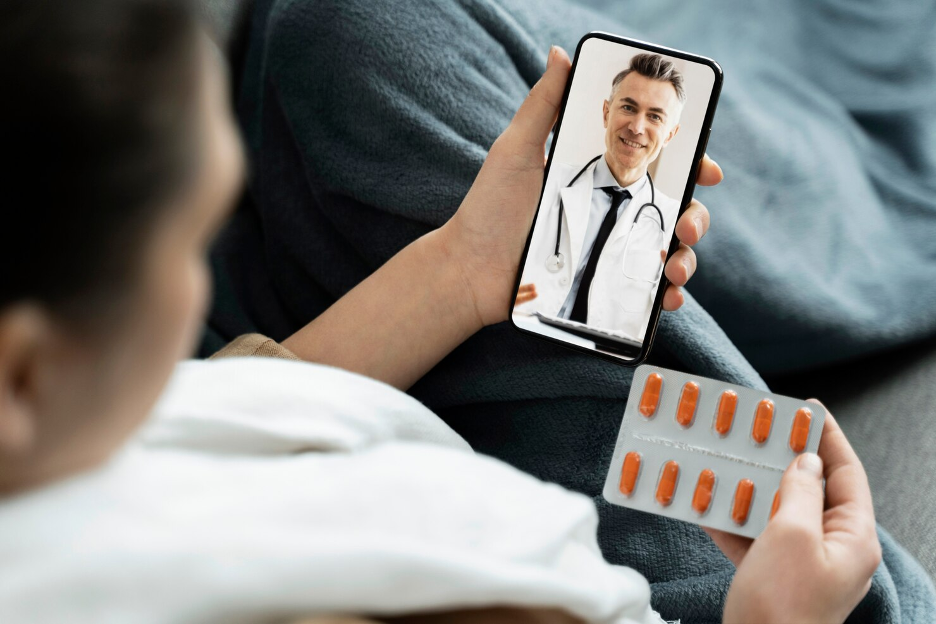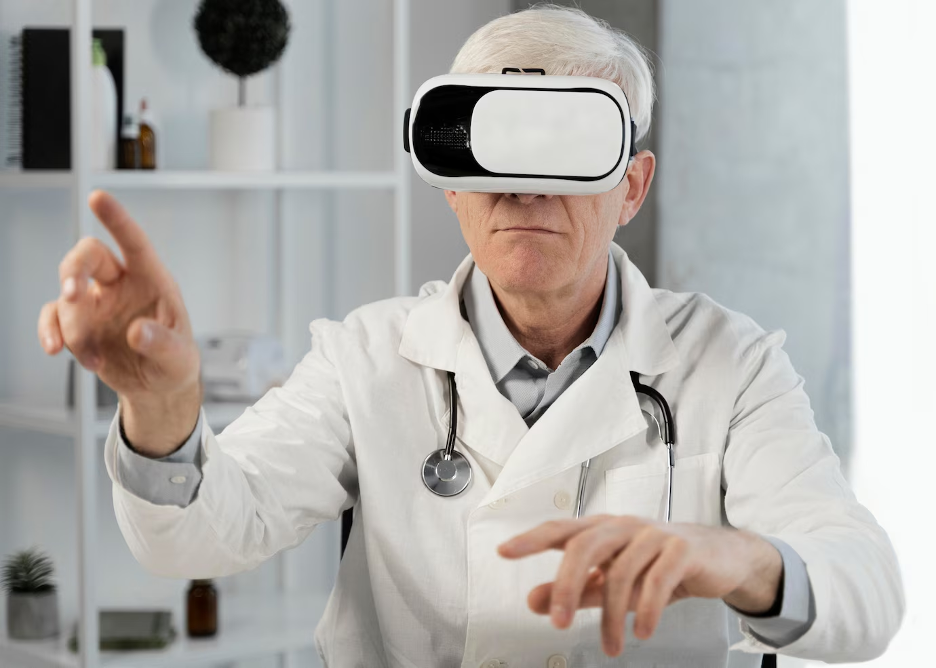
Image by Freepik
Today, connectivity is not just a convenience but a necessity. Nowhere is this more evident than in the healthcare industry, where connectivity can mean the difference between life and death. Despite the crucial role of technology, the healthcare sector has been notoriously slow in adopting innovations.
The reasons are valid. The complexities and regulations that govern medical practices require a more cautious approach. Often, this delays the integration of technologies that could significantly enhance patient care.
However, the advent of mobile technology is gradually breaking down these barriers, offering transformative solutions that benefit all stakeholders. It improves accessibility, efficiency, and patient outcomes, making healthcare more responsive and patient-centred.
One study concluded that healthcare organisations, regardless of size, should focus on embracing a broader digital transformation paradigm. This approach involves implementing information technology projects and continuously adapting and realigning organisational strategies. Therefore, management practices should integrate technology adoption and ongoing organisational change to maximise the advantages of digital solutions.
How Mobile Technology Is Changing the Landscape of Patient Care
Mobile technology is reshaping healthcare delivery, making it more dynamic and responsive to the needs of patients and providers alike. Let’s take a closer look at how it is transforming patient care.
Enhances accessibility to healthcare
Mobile technology has made telemedicine widely accessible, letting patients speak with healthcare professionals from the comfort of their homes. This is particularly advantageous for those living in remote or underserved areas with limited access to medical facilities. Telemedicine apps facilitate video consultations, enabling real-time interactions between patients and doctors.
Telemedicine lessens travel costs and time by reducing the need for physical visits. It helps decongest hospitals and clinics, allowing healthcare specialists to manage their time more efficiently and attend to more patients virtually.
A survey showed that 76.7% of primary care doctors report giving the same quality of care for telemedicine visits.
Furthermore, mobile technology facilitates continuous monitoring of chronic conditions. Wearable devices and mobile apps can track vital signs such as heart rate, blood pressure, and glucose levels. This constant monitoring aids in the timely detection of potential health issues, enabling prompt interventions and reducing the risk of complications.
Streamlines communication and coordination
Effective communication among medical professionals and patients is crucial for quality care, and mobile technology has made this more accessible than ever. Secure messaging apps and patient portals allow for seamless communication. Patients can ask questions, share concerns, and receive prompt responses from their healthcare providers. This immediate access to information helps alleviate patient anxiety and fosters a stronger patient-provider relationship.
Mobile technology also enhances coordination among healthcare teams. Electronic health records (EHRs) accessible via mobile devices ensure that all team members are on the same page. This real-time access to patient data minimises the risk of errors and ensures consistent care.
Mobile apps designed for healthcare professionals can facilitate quick consultation among specialists, allowing for collaborative decision-making and more comprehensive patient care.
Empower patients through education and engagement
Healthcare is now more collaborative. With mobile technology, patients can access tools and resources that will encourage them to take an active role in their healthcare.
Health apps offer a wealth of information on various conditions, treatments, and wellness practices. Interactive features such as reminders for medication adherence, exercise routines, and dietary guidelines encourage patients to maintain healthy behaviours.
Patient engagement is further enhanced through gamification elements in health apps. By turning health management into a game with rewards and milestones, these apps motivate patients to adhere to their treatment plans. For instance, apps that track physical activity and offer virtual badges for achieving fitness goals can make managing conditions more engaging.
Improve efficiency in healthcare delivery
Integrating mobile technology into healthcare has led to significant improvements in efficiency. Automated appointment scheduling and reminders reduce no-show rates and ensure healthcare providers can manage their time effectively.
A survey found that new patients in 15 metropolitan areas experience an average wait time of 26 days. This finding highlights the significant delay in accessing physician appointments for new patients. With mobile tech, patients benefit from reduced waiting times and better access to healthcare services.
Mobile check-in and digital forms streamline the administrative process, minimising paperwork and allowing healthcare providers to focus more on patient care.
Mobile technology is also a game-changer in managing emergency situations. Emergency medical services (EMS) use mobile apps to access real-time information. Apps help them navigate the scene quickly and communicate with hospitals to prepare for incoming patients. This rapid response capability can be lifesaving, particularly in cases of cardiovascular events, strokes, or severe trauma. Transferring patient data en route to the hospital ensures the receiving medical team is prepared and can begin treatment upon arrival.
Enhances data collection and analysis
The vast amount of data generated by mobile health technologies provides valuable insights into patient health and healthcare delivery. Advanced analytics algorithms can process and analyse patient data to identify patterns, predict outcomes, and personalise treatment plans. For example, predictive analytics can scan family history and genetic makeup to identify patients at risk of developing chronic conditions. When the data is collated and analysed, doctors can suggest early intervention and preventive measures.
In the US, chronic diseases are the primary causes of death and disability. They are the main contributors to the country's annual health costs of over one trillion. Five chronic conditions—cancer, cardiovascular disease, diabetes, obesity, and kidney disease—represent 75% of healthcare expenditures.
Mobile technology also supports large-scale health studies by facilitating data collection from diverse populations. Research apps and platforms enable participants to contribute data effortlessly, broadening the scope and scale of health research. This democratisation of data collection can lead to more inclusive and representative studies. Ultimately, it improves our understanding of various health conditions and informs public health strategies.
Challenges To Security and Access
While mobile technology offers numerous benefits, it also presents challenges. Data security and privacy can be concerning, as sensitive patient and health information is transmitted and stored digitally. Ensuring the confidentiality and integrity of this data requires robust encryption, secure authentication methods, and adherence to regulations.
Another challenge is the digital divide, which can limit the benefits of mobile technology for specific populations. Older adults, low-income individuals, and those with limited digital literacy may find it difficult to use mobile health tools.
Efforts to bridge this gap include designing user-friendly interfaces, providing digital literacy training, and presenting affordable access to devices and internet services. Thankfully, AARP Consumer Cellular offerings can provide older adults with mobile phone plans that suit their needs.
Additionally, healthcare providers need continuous education and support to maximise the use of these technologies. Training programmes and resources should be made available to ensure that medical staff are proficient in using mobile health tools. This comprehensive approach can promote a broader and more effective adoption of mobile technology in healthcare.
Future Directions and Innovations

Image by Freepik
The future of mobile technology in healthcare looks incredibly promising, with advancements poised to revolutionise patient care and healthcare delivery.
Artificial intelligence and machine learning
AI and ML are set to transform healthcare by improving diagnostic precision and enabling highly personalised treatment plans. AI algorithms can rapidly analyse vast amounts of medical data, identifying patterns and insights that human practitioners may miss.
For instance, AI-powered diagnostic tools can analyse medical images, like X-rays and MRIs, with a level of accuracy and speed that trumps traditional methods. These advanced algorithms can detect early signs of diseases like cancer, allowing for timely intervention and improved patient outcomes.
AI-powered chatbots are another promising innovation. These chatbots can provide immediate medical advice, triage patients depending on their symptoms, and direct them to the appropriate care pathways. This can be particularly beneficial in managing patient flow in emergency departments and providing initial consultations for non-critical conditions, thereby reducing wait times and freeing up medical staff to focus on more severe cases.
Internet of Things (IoT) integration
Another exciting development that holds immense potential is the Internet of Things (IoT). IoT-enabled smart home devices, such as connected scales, blood pressure monitors, and sleep trackers, offer a comprehensive and continuous view of a patient's health status. These devices can track vital signs and pertinent health indicators in real-time, transmitting data to healthcare providers, who can then analyse it to make informed decisions.
For example, a connected blood pressure monitor can alert the patient and their doctor to any significant changes, allowing for immediate adjustments to treatment plans.
Similarly, sleep trackers can provide insights into a patient’s sleep patterns, helping to diagnose and manage conditions like sleep apnoea or insomnia. By providing continuous, real-time feedback, these IoT devices allow patients to be more proactive in their health management. At the same time, it will also enable healthcare providers to offer personalised care.
Holistic health management
Combining AI, ML, and IoT technologies facilitates a holistic approach to health management. Mobile health apps integrating data from various IoT devices can offer a comprehensive overview of a patient’s health, helping identify potential issues before they become serious. For instance, a health app could aggregate data from a fitness tracker, connected scale, and sleep monitor to provide personalised recommendations on diet, exercise, and sleep hygiene.
Moreover, these technologies can support chronic disease management by enabling continuous monitoring and early intervention. Patients with diabetes or hypertension can benefit from regular updates and alerts regarding their health status, allowing for timely adjustments to medications or lifestyle changes. This approach can minimise the risk of complications and improve overall health outcomes.
Future innovations on the horizon
Looking ahead, the potential for innovation in mobile health technology is vast. Future developments may include even more sophisticated AI algorithms capable of predicting health issues before they arise, advanced wearable devices that can monitor a broader range of health metrics, and more integrated health platforms that offer seamless connectivity between patients, healthcare providers, and medical devices.
Additionally, advancements in virtual reality (VR) and augmented reality (AR) could further enhance patient care. They can provide immersive training for healthcare professionals and innovative therapeutic options for patients.
For example, specialists can use VR for pain management or mental health therapies. ARs, on the other hand, could assist surgeons with real-time, detailed visualisations during complex procedures.
Embrace Mobile Technology for Better Health Outcomes
The use of mobile technology in healthcare is transforming patient care, making it more accessible, efficient, and personalised. From telemedicine and remote monitoring to patient education and data analytics, mobile technology offers a myriad of advantages that improve the quality of care. Keeping an open mind for these technological advancements will be crucial in addressing current challenges and improving health outcomes for all.
Healthcare providers, policymakers, and technology developers must collaborate to ensure that mobile health solutions are secure, inclusive, and effective. By doing so, we can harness mobile technology's full potential to create a more connected and healthier future.
This article is part of the HealthManagement.org Point-of-View Programme.
References:
- Emerald (2021) Adopting a digital transformation paradigm in healthcare management. Available at https://www.emerald.com/insight/content/doi/10.1108/XJM-04-2021-0121/full/html
- Centers for Disease Control and Prevention (2023) Data Brief No. 493: Telemedicine Use Among Adults. Available at https://www.cdc.gov/nchs/products/databriefs/db493.htm
- ResearchGate (2023) Analyzing the Role of Health Apps in Promoting Healthy Lifestyle and Preventive Care. Available at https://www.researchgate.net/publication/375742749_Analyzing_the_Role_of_Health_Apps_in_Promoting_Healthy_Lifestyle_and_Preventive_Care
- The Washington Post (2023) Medical appointments: avoiding long waits. Available at https://www.washingtonpost.com/wellness/2023/10/30/medical-appointments-avoiding-long-waits/
- National Center for Biotechnology Information (2023) Trends in telehealth use. Available at https://www.ncbi.nlm.nih.gov/pmc/articles/PMC10830426/





